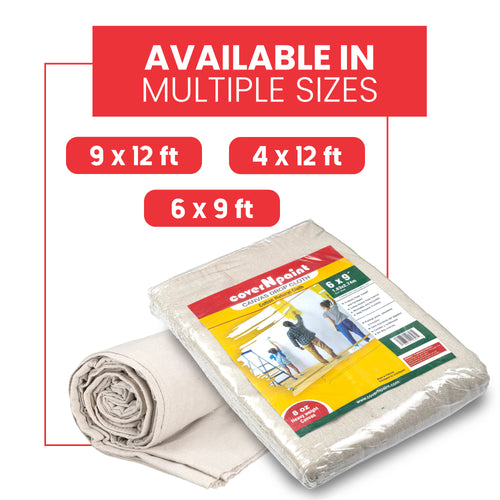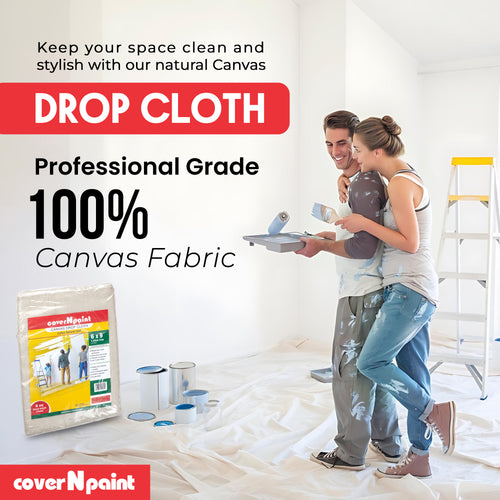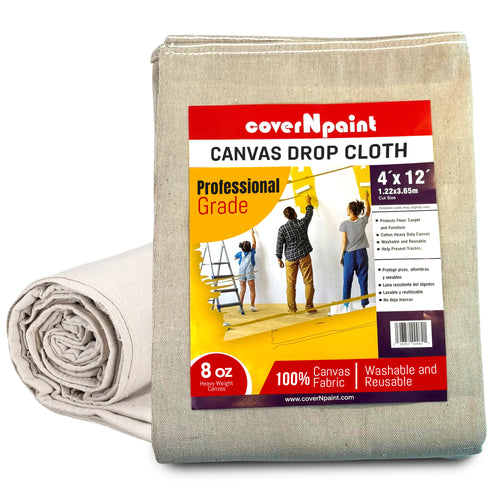When starting a painting project, many people wonder if investing in a paint drop cloth is truly necessary. This decision might appear minor at first, but the consequences of skipping it can be quite substantial.
Understanding the Purpose of a Protective Floor Covering
The primary purpose of a protective floor covering is to shield surfaces from paint spills, splatters, and drips. When you're painting, it's almost inevitable that some paint will escape your brush or roller, no matter how careful you are. This can lead to unsightly stains and damage to floors, furniture, and other surfaces.

Types of Protective Floor Coverings
There are several types of protective floor coverings available, each with its own set of advantages and disadvantages. Let's explore some of the most common options:
Canvas Sheets
Canvas sheets are a popular choice among professional painters and DIY enthusiasts alike. Made from heavy-duty cotton, they are highly absorbent and can withstand repeated use. Canvas sheets provide excellent protection against paint spills and splatters, as the thick fabric prevents paint from seeping through to the surface below. Additionally, they are reusable, making them a cost-effective option in the long run.
Plastic Tarps
Plastic tarps are another widely used option for protecting surfaces during painting projects. They are lightweight, waterproof, and inexpensive, making them a convenient choice for many homeowners. Plastic tarps are available in various thicknesses, with thicker tarps offering better durability and protection.
Paper Drop Sheets
Paper drop sheets are a disposable option that provides a quick and easy solution for protecting surfaces. They are lightweight and come in large rolls, allowing you to cover a significant area with minimal effort. Paper drop sheets are also relatively inexpensive, making them a good choice for one-time projects.
Adhesive Floor Protection Films
Adhesive floor protection films are a specialized type of protective covering designed to stick to surfaces, preventing them from shifting during use. These films are typically made from a durable plastic material and are available in various thicknesses.
The Consequences of Not Using a Protective Covering
Choosing not to use a protective floor covering can lead to several negative consequences, both immediate and long-term. Here are some of the potential risks:
Permanent Stains
One of the most obvious risks of not using a protective covering is the possibility of permanent stains. Paint can be notoriously difficult to remove from certain surfaces, especially porous materials like carpets and unsealed wood. Even a small spill can leave a lasting mark that detracts from the overall appearance of your space.
Damage to Surfaces
In addition to staining, paint can cause physical damage to certain surfaces. For example, paint can seep into the seams of hardwood floors, causing the wood to swell and warp. Similarly, paint can damage the finish on tiles, making them more susceptible to cracking and chipping.
Increased Cleanup Time
Without a protective covering, you'll likely spend a significant amount of time cleaning up after your painting project. Scrubbing paint off floors, furniture, and other surfaces can be a labor-intensive process, especially if the paint has dried. Using a protective covering can help minimize the need for extensive cleanup, allowing you to enjoy your freshly painted space sooner.
Safety Hazards
Paint spills can create slippery surfaces, increasing the risk of slips and falls. This is particularly concerning if you're working on a ladder or scaffolding, as a fall from height can result in serious injury. A protective covering can help prevent paint from creating hazardous conditions, keeping your workspace safer.

Selecting the Right Protective Covering for Your Project
Choosing the right protective covering for your painting project depends on several factors, including the type of surface you're protecting, the scope of your project, and your budget. Here are some tips to help you make an informed decision:
Consider the Surface Type
Different surfaces require different levels of protection. For example, carpets and hardwood floors may benefit from adhesive floor protection films or heavy-duty canvas sheets, while plastic tarps may be sufficient for tile or vinyl floors. Consider the specific needs of your surface when selecting a protective covering.
Evaluate Durability
If you're planning multiple painting projects or anticipate heavy use, investing in a more durable protective covering like canvas sheets may be worthwhile. On the other hand, if you're only painting a small area or a single room, a disposable option like paper drop sheets may be more practical.
Assess Ease of Use
Some protective coverings are easier to handle and apply than others. For example, adhesive films require careful application to avoid wrinkles and bubbles, while canvas sheets and plastic tarps can be quickly spread out and adjusted as needed. Consider your level of comfort and experience with each type of covering when making your selection.
Factor in Cost
Cost is always a consideration when planning a home improvement project. While canvas sheets may have a higher upfront cost, their reusability can make them a more cost-effective option in the long run. Conversely, disposable coverings like paper drop sheets and plastic tarps may be more budget-friendly for one-time projects.
Environmental Considerations
In today's environmentally conscious world, it's important to consider the environmental impact of your choices. Protective coverings made from sustainable materials, like canvas sheets, are a more eco-friendly option compared to disposable plastic tarps and paper drop sheets. Additionally, reusable coverings reduce waste and minimize the environmental footprint of your painting project.
Best Practices for Using a Protective Floor Covering
To get the most out of your protective covering, it's essential to use it correctly. Here are some best practices to ensure optimal protection and efficiency:
Protect Vertical Surfaces
In addition to covering the floor, consider using protective coverings to shield vertical surfaces like walls and furniture. This is especially important if you're using a paint sprayer, as overspray can easily reach unintended areas.
Clean Up Spills Immediately
If paint does spill or splatter on your protective covering, clean it up as soon as possible to prevent it from spreading. Use a damp cloth or paper towel to blot the spill, and avoid rubbing, as this can cause the paint to spread further.













